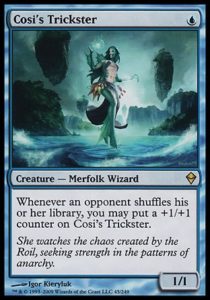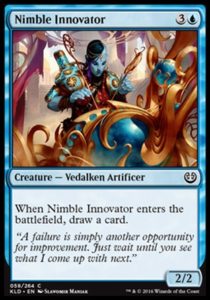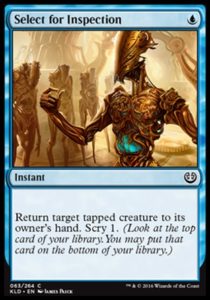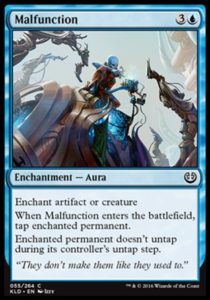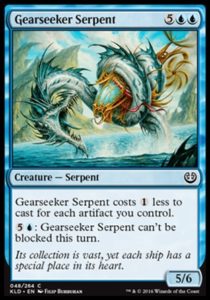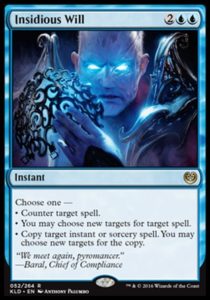Blue is often one of the hardest colors to evaluate. Sometimes, it’s obviously excellent (as in Battle for Zendikar and Avacyn Restored). Other times, it’s obviously the worst color (as in Shadows Over Innistrad and Scars of Mirrodin). When blue’s not obviously the best or worst, it’s usually the most difficult color to evaluate. It initially appeared to be a weak color in Gatecrash and Khans of Tarkir but turned out to be a dominant force in those Limited environments.
Blue in Kaladesh is perplexing, but to an extent I’ve never seen before. Why is this? Is blue secretly good or overtly terrible? And why is it so hard to evaluate this time? Let’s dive right in.
Innately Tricky
Blue’s strengths tend to be more subtle than other colors’, making it difficult to evaluate. Its creatures are smaller, its removal more conditional, and its interactions are more complicated, but it (usually more than any other color) comes together as a cohesive whole that is more than the sum of its parts.
When blue is good, it’s usually because its creatures aren’t so small or inefficient compared to the other colors’ creatures (Eldrazi Skyspawner, Azure Drake in M11); its removal is unusually strong (Clutch of Currents, Mist Raven, Voyage’s End); or its card advantage is overpowered (Treasure Cruise, Opportunity and Divination in M14).
When blue is bad, the opposite is true: its creatures are too slow or small (Shadows Over Innistrad), its removal is weak (Dragons of Tarkir), or its card advantage is undesirable (Zendikar). None of its cards or synergies are powerful enough to contend with what every other color can do.
Kaladeshi Blue Does it All
In Kaladesh Limited, blue has all of the tools it normally needs at common: evasion (Dukhara Peafowl, Wind Drake), removal (Select for Inspection, Malfunction), card advantage (Nimble Innovator, Tezzeret’s Ambition) and a powerful synergy-dependent card (Gearseeker Serpent). On the face of it, blue should be quite strong.
The problem is that every color seems to be stronger. Blue might have evasion, but its creatures struggle to deal with a three-power creature. Normally that wouldn’t be a big problem, since cheap three-power creatures are unusual in Limited. However, red and black both have them for two mana (Thriving Grubs, Dhund Operative), white has a 3/3 for three (Glint-Sleeve Artisant), and green has a 3/4 for three (Thriving Rhino). These are enormous creatures for common and blue has nothing comparably aggressive. If Kaladesh is a highly aggressive format, blue’s creatures are too slow to defend against the onslaught and too weak to be reasonable substitutes for any other colors’.
But how about blue’s removal?
Bouncing Back
Bounce spells have become blue’s bread and butter. When blue is able to play a tempo game, bounce spells are the most mana-efficient removal in the format. When bounce spells come with upside, as with Voyage’s End and Drag Under, they tend to be excellent. The trick to bounce spells is maximizing their impact.
Unsummon effects are at their very best when a deck is on the attack, since a creature that an opponent doesn’t have time to recast is effectively dead. They’re excellent when you’re in a race, when they give you just enough of an edge to turn the tide. When you’re behind, they’re awkward since you’re trading a card for life points and a temporary board advantage. That’s fine if you have big things you’re buying time for, but terrible otherwise since you’re just forestalling your loss. In that case, it’d be better to just have another spell. Unsummon effects are at their best when they produce a large mana advantage by bouncing a large creature. All removal is judged by this metric, but for bounce this is even more important since you’re not permanently killing anything.
The problem with Select for Inspection is that when bounce is most powerful (when you’re the beatdown), it doesn’t work. It shaves a mana off of Voyage’s End and loses the best part of the card. In addition, a large number of Kaladeshi creatures have large amount of enters-the-battlefield abilities (making them worse to bounce) and there are many powerful cheap creatures (which produce less of a mana advantage when bounced). A lot of the value of a one-mana bounce spell is both mitigated by the format and lost on the card’s restriction.
The problem with blue’s other bounce spell, Aether Tradewinds, is that it’s not at all mana efficient. Yes, it can generate card advantage when recurring an ETB effect, but three mana and a permanent is a lot to give up for a spell designed to generate a temporary mana and board advantage.
If It Ain’t Broke
Blue has been getting Pacifism effects more frequently, such as Sleep Paralysis and Claustrophobia. Normally, this is a great boon for blue, since it usually lacks actual removal spells. However, there is an enormous difference between Pacifism and Revoke Priveliges costing two or three, and Malfunction costing four.
A four-mana removal spell is excellent in a format where small creatures are (relatively) easily dealt with and expensive creatures are the real threats. For example, Oblivion Strike and Isolation Zone were excellent in Oath of the Gatewatch. That spell is much worse when two-drop creatures demand answers (as they do in Kaladesh) and aren’t easily answered by a color’s creatures. Moreover, Kaladesh has multiple ways of sidestepping aura-based removal, such as Aviary Mechanic, Dhund Operative and Inventor’s Apprentice (which are perfectly happy if you lock down an artifact), or Armorcraft Judge.
In short, Malfunction is an extremely powerful effect, but the format may weaken its utility. It suffers from many of the same problems that Sleep Paralysis did.
Strengths in Tension
Blue has two major themes: artifacts-matter and energy. These themes exist in tension: blue is excellent at producing energy but poor at using it (at common), and blue relies on having artifacts but both lacks Fabricate and is the worst color at utilizing vehicles (since its creatures have the lowest power).
Gearseeker Serpent is an incredibly powerful card, one that rewards a dedicated, artifact-heavy blue drafter. However, it relies on cards like Prophetic Prism and Cogworker’s Puzzleknot to function, cards which don’t match up well against Thriving Grubs or Glint-Sleeve Artisan, because you’re spending two mana and a card for minimal board impact. Additionally, there is little else to reward an artifact-heavy blue draft. Unless one is able to pick up three or more copies of Gearseeker Serpent, one has to contort one’s deck heavily in order to accommodate a strong, but not excellent threat.
Aether Theorist and Hightide Hermit produce large quantities of energy, but neither creature has particularly strong stats. Aether Theorist‘s scry ability is good, but it’s not a sink for large quantities of energy. Hightide Hermit‘s ability is terrible. Unless you’re able to utilize its energy, it’s just worse than Self-Assembler or Bastion Mastodon. The only other common means of spending energy is Thriving Turtle, a solid defensive creature but a terrible offensive one.
An Unanswered Question
I keep being ready to write blue off as terrible, but my strong Limited players retort that blue is great. I keep seeing blue perform admirably on stream or against me (and sometimes even in my own hands). It’s easy to see blue’s strengths (because it has all the tools it normally needs to succeed) and weaknesses (because of how powerful everything else is or how small and conditional blue’s power is).
The big takeaway for me is that Kaladesh may be the most difficult, inscrutable Limited format I’ve ever played. The context is fluid, creating high ceilings and low floors for how well (a whole lot of) cards can perform. Blue can be considered both the best and worst color, depending on perspective (and less on objective truth). Kaladesh is not like a Masters set, where card complexity or interactions are hard to see; it’s a format where each card has dramatically different value based on the immediate context and minute differences in deckbuilding. It may be one of the most brilliant Limited designs in that it is extremely deep and varied, while masking much of this complexity from less experienced players. I look forward to doing my best to master it and hope that it represents a new and greater age in Magic set design.
And, as always, thanks for reading.
—Zachary Barash
Zachary Barash is a New York City-based game designer. He’s played Magic since 1994, he loves Limited and drafts every available format (including several that aren’t entirely meant to be drafted). He quite enjoys Revolutionary Rebuff, since that card demonstrates just how insanely good Mana Leak and Miscalculate are.

